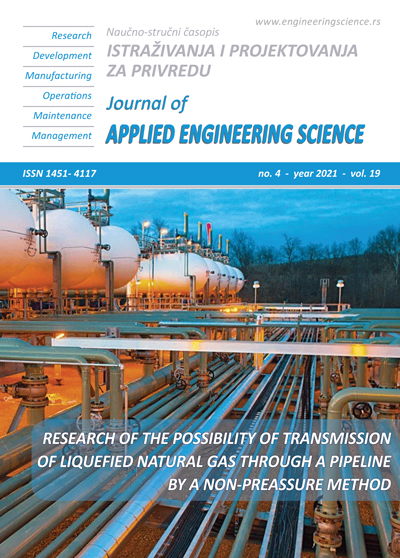OPTIMIZING THE MUTUAL ARRANGEMENT OF PILOT INDICATORS ON AN AIRCRAFT DASHBOARD AND ANALYSIS OF THIS PROCEDURE FROM THE VIEWPOINT OF QUANTUM REPRESENTATIONS
Abstract
The purpose of this work is to present the first attempt to provide quantitative analysis and objective justification for designers’ decisions that relate to the arrangement of pilot indicators on an aircraft dashboard with the use of video oculography measurements. To date, such decisions have been made only based on the practical experience accumulated by designers and subjective expert assessments. A new method for optimizing the mutual arrangement of the dashboard indicators is under consideration. This is based on iterative correction of the gaze transition probability matrix between the selected zones of attention, to minimize the difference between the stationary distribution of relative frequencies of gaze that are staying in these zones and the corresponding desirable target eye movements that are given for distribution for qualified pilots. When solving the subsequent multidimensional scaling problem, the gaze transition probability matrix that is obtained is considered to be the similarity matrix, the elements of which quantitatively characterize the proximity between the zones of attention. The main findings of this novel work are as follows: the use of oculography data to justify dashboard design decisions, the optimizing method itself, and its mathematical components, as well as analysis of the optimization in question from the viewpoint of quantum representations, all revealed design mistakes. The results that were obtained can be applied for prototyping variants of aircraft dashboards by rearranging the display areas associated with the corresponding zones of attention.
References
Barabanschikov, V.A., Zhegallo, A.V. (2013). Registration and analysis of the orientation of a person's gaze. Institute of Psychology of the Russian Academy of Sciences, Moscow.
Bastani, V., Marcenaro, L., Regazzoni, C. (2014). Unsupervised trajectory pattern classification using hierarchical Dirichlet Process Mixture hidden Markov model. IEEE International Workshop on Machine Learning for Signal Processing, p. 1-6, DOI: 10.1109/MLSP.2014.6958916
Borg, I., Groenen, P.J.F. (2005). Modern multidimensional scaling: Theory and applications. Springer, New York, DOI: 10.1007/0-387-28981-X
Cottrell, M., Faure, C., Lacaille, J., Olteanu, M. (2019). Anomaly detection for bivariate signals. Rojas, I., Joya, G., Catala, A. (Eds.), Advances in Computational Intelligence. IWANN 2019. Lecture Notes in Computer Science, vol. 11506. Springer, Cham, p. 162—173, DOI: 10.1007/978-3-030-20521-8_14
Bress, T.J. (2013). Effective LabVIEW programming. National Technology & Science Press, Austin, Texas.
Cox, T.F., Cox, M.A.A. (2001). Multidimensional scaling. 2nd ed. Chapman & Hall/CRC, Boca Raton, Florida.
Cramer, H. (1999). Mathematical methods of statistics. Princeton University Press, Princeton, New Jersey.
Eerland, W.J., Box, S. (2016). Trajectory clustering, modelling and selection with the focus on airspace protection. AIAA Infotech@ Aerospace, p. 1-14, DOI: 10.2514/6.2016-1411
Faure, C., Olteanu, M., Bardet, J.M., Lacaille, J. (2017). Using self-organizing maps for clustering and labelling aircraft engine data phases. 12th International Workshop on Self-Organizing Maps and Learning Vector Quantization, Clustering and Data Visualization, p. 1-8, DOI: 10.1109/WSOM.2017.8020013
Hung, C., Peng, W., Lee, W. (2015). Clustering and aggregating clues of trajectories for mining trajectory patterns and routes. The VLDB Journal - The International Journal on Very Large Data Bases, vol. 24, no. 2, 169-192, DOI: 10.1007/s00778-011-0262-6
Krasilshchikov, M.N., Evdokimenkov, V.N., Bazlev, D.A. (2011). Individually adapted on-board systems for monitoring the technical condition of the aircraft and supporting the pilot's control actions. MAI, Moscow.
Kuravsky, L.S. (2021). Modeling dynamical behavior of stochastic systems: spectral analysis of qubit representations vs. the mutual Markovian model likelihood estimations. Lobachevskii Journal of Mathematics, vol. 42, no. 11.
Kuravsky, L.S., Yuryev, G.A., Zlatomrezhev, V.I., Yuryeva, N.E. (2020). Assessing the aircraft crew actions with the aid of a human factor risk model. Eksperimental’nayapsikhologiya = Experimental Psychology, vol. 13, no. 2, 153-181, DOI: 10.17759/exppsy.2020130211
Kuravsky, L.S., Yuryev, G.A., Zlatomrezhev, V.I., Greshnikov, I.I., Polyakov, B.Y. (2021). Assessing the aircraft crew activity basing on video oculography data. Eksperimental’nayapsikhologiya = Experimental Psychology, vol. 14, no. 1, 204-222, DOI: 10.17759/exppsy.2021140110
Lancaster, P. (1969). Theory of matrices. Academic Press, New York.
Laxhammar, R., Falkman, G. (2014). Online learning and sequential anomaly detection in trajectories. IEEE Transactions on Pattern Analysis and Machine Intelligence, vol. 36, no. 6, 1158-1173, DOI: 10.1109/TPAMI.2013.172
Report on applied research on the topic "Development of human factor risk models and recommendations for creating a human-machine interface for the aircraft crew cabin" (intermediate), stage 1, State program of the Russian Federation "Development of the aviation industry for 2013-2025", grant agreement dated 21.10.2019. No. 075-11-2019-018, state registration no. RFMEFI62819X0014.
Report on applied research on the topic "Development of human factor risk models and recommendations for creating a human-machine interface for the aircraft crew cabin" (final), stage 2, State program of the Russian Federation "Development of the aviation industry for 2013-2025", grant agreement dated 21.10.2019. No. 075-11-2019-018, state registration no. RFMEFI62819X0014.
Rintoul, M., Wilson, A. (2015). Trajectory analysis via a geometric feature space approach. Statistical Analysis and Data Mining, vol. 8, no. 5-6, 287-301, DOI: 10.1002/sam.11287
Wei, J., Sciandra, V., Hwang, I., Hall, W.D. (2014). Design and evaluation of a dynamic sectorization algorithm for terminal airspace. Journal of Guidance, Control, and Dynamics, vol. 37, no. 5, 1539-1555, DOI: 10.2514/1.G000345
Wilson, A., Rintoul, M., Valicka, C. Exploratory trajectory clustering with distance geometry. Schmorrow, D., Fidopiastis, C. (Eds.), Foundations of Augmented Cognition: Neuroergonomics and Operational Neuroscience. AC 2016. Lecture Notes in Computer Science, vol. 9744. Springer, Cham, p. 263-274, DOI: 10.1007/978-3-319-39952-2_2

